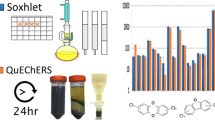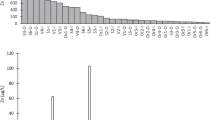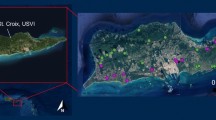Abstract
The defensibility of field sampling data collected in support of natural resource damage assessments and other environmental investigations depends on rigorous quality assurance and control both in the field and laboratory. One important step in field procedures is the cleaning of sampling equipment between samples to minimize the carryover of contaminants. Large-scale sampling efforts during the Deepwater Horizon oil spill event have highlighted the importance of understanding how multiple equipment cleaning protocols affect interstation cross-contamination and the resulting chemical data quality. In this study, six field cleaning techniques were tested on metal sampling equipment using two different sediment types spiked with crude oil in order to understand their relative and absolute effectiveness in reducing chemical carryover. The complexity of the cleaning protocols ranged from a simple water and scrub brush application to protocols that included soap and/or solvent. In this study, percent residual hydrocarbon transfer, relative to total loading in sediments, never exceeded 0.032%. The least labor-intensive protocol, water and scrub brush application, had the highest potential for hydrocarbon transfer (0.011–0.032%). Statistical differences were observed among treatments, and it was found that protocols containing a solvent step were more effective than protocols without solvents. Depending on the data quality objectives, the differences may not be meaningful, and choosing a cleaning technique should be governed by health, safety, and environmental factors. The residual hydrocarbons measured after equipment cleanings for all techniques in this study were negligible when compared with other variables that occur during routine sampling and laboratory activities.



Similar content being viewed by others
References
Apeti DA, Hartwell SI, Johnson WE, Lauenstein GG (2012) National status and trends bioeffects program: field methods. NOAA National Centers for Coastal Ocean Science, Center for Coastal Monitoring and Assessment. NOAA NCCOS Technical Memorandum 135. Silver Spring, MD.
Balthis L, Hyland J, Cooksey C, Wirth E, Fulton M, Moore J, Hurley D (2012) Support for integrated ecosystem assessments of NOAA’s National Estuarine Research Reserve System (NERRS): assessment of ecological condition and stressor impacts in subtidal waters of the Sapelo Island National Estuarine Research Reserve. NOAA Technical Memorandum NOS NCCOS 150. NOAA Center for Coastal Environmental Health and Biomolecular Research, Charleston, SC
Bejarano AC, Michel J, Allan SE (2014) Guidelines for collecting high priority ephemeral data for oil spills in the Arctic in support of natural resource damage assessments. NOAA Office of Response and Restoration
Boehm PD, Murray KJ, Cook LL (2016) Distribution and attenuation of polycyclic aromatic hydrocarbons in Gulf of Mexico seawater from the Deepwater Horizon oil accident. Environ Sci Technol 50:584–592. https://doi.org/10.1021/acs.est.5b03616
Chung KWC (1999) Toxicity of cadmium, DDT, and fluoranthene to juvenile Mercenaria mercenaria in aqueous and sediment bioassays. Master's Thesis, University of Charleston, South Carolina
Cook RD (1977) Detection of influential observation in linear regression. Technometrics. 19:15–18. https://doi.org/10.2307/1268249
DWH Trustees (2016) Deepwater Horizon oil spill: final programmatic damage assessment and restoration plan and final programmatic environmental impact statement. http://www.gulfspillrestoration.noaa.gov/restoration-planning/gulf-plan. Accessed March 17 2020
Fish Technical Working Group of the Mississippi Canyon 252 Trustees (2011) Submerged oil characterization across multiple habitats for assessment of persistent exposures in nearshore sediments Deepwater Horizon Oil Spill (DWHOS). https://www.fws.gov/doiddata/dwh-ar-documents/824/DWH-AR0014930.pdf. Accessed January 6 2021
Fisher R, Keefe J, Maxfield R (2004) Standard operating procedure for soil, sediment, and solid waste sampling. USEPA The Office of Environmental Measurenment and Evaluation, North Chelmsford, MA
Folk RL (1980) Petrology of sedimentary rocks. Hemphill Publishing Company, Austin, TX
Heiri O, Lotter AF, Lemcke G (2001) Loss on ignition as a method for estimating organic and carbonate content in sediments: reproducibility and comparability of results. J Paleolimnol 25:101–110. https://doi.org/10.1023/a:1008119611481
ICCOPR (2015) Interagency coordinating committee on oil pollution research: oil pollution research and technology plan.
Karickhoff S, Brown D, Scott T (1979) Sorption of hydrophobic pollutants on natural sediments. Water Res 13:241–248. https://doi.org/10.1016/0043-1354(79)90201-x
Key P, Chung K, Siewicki T, Fulton M (2007) Toxicity of three pesticides individually and in mixture to larval grass shrimp (Palaemonetes pugio). Ecotoxicol Environ Saf 68:272–277. https://doi.org/10.1016/j.ecoenv.2006.11.017
Kucklick JR, Sivertsen SK, Sanders M, Scott GI (1997) Factors influencing polycyclic aromatic hydrocarbon distributions in South Carolina estuarine sediments. J Exp Mar Biol Ecol 213:13–29. https://doi.org/10.1016/s0022-0981(97)00007-5
Lewis DW (1984) Practical sedimentology. Hutchinson Ross, New York, NY
Lewis DW, McConchie DM (1994) Analytical sedimentology. Chapman & Hall, London
Long ER et al. (1998) Magnitude and extent of sediment toxicity in selected estuaries of South Carolina and Georgia. NOAA Technical Memorandum NOS ORCA 128. Silver Spring, MD
Maruya KA, Risebrough RW, Horne AJ (1996) Partitioning of polynuclear aromatic hydrocarbons between sediments from San Francisco Bay and their porewaters. Environ Sci Technol 30:2942–2947. https://doi.org/10.1021/es950909v
Means JC, Wood SG, Hassett JJ, Banwart WL (1980) Sorption of polynuclear aromatic hydrocarbons by sediments and soils. Environ Sci Technol 14:1524–1528. https://doi.org/10.1021/es60172a005
NOAA OR&R (2017) Assessing the impacts from Deepwater Horizon. https://response.restoration.noaa.gov/ about/media/assessing-impacts-deepwater-horizon.html. Accessed March 17 2020
Piwoni MD, Keeley JW (1990) Basic concepts of contaminant sorption at hazardous waste sites. US Environmental Protection Agency, Office of Research and Development
Plumb RH (1981) Procedures for handling and chemical analysis of sediment and water samples. Environmental Laboratory U.S. Army Engineer Waterways Experiment Station, Vicksburg, MS
Ragland JM, Liebert D, Wirth E (2014) Using procedural blanks to generate analyte-specific limits of detection for persistent organic pollutants based on GC-MS analysis. Anal Chem 86:7696–7704. https://doi.org/10.1021/ac501615n
Rouhani S, Baker MC, Steinhoff M, Zhang M, Oehrig J, Zelo IJ, Emsbo-Mattingly SD, Nixon Z, Willis JM, Hester MW (2017) Nearshore exposure to Deepwater Horizon oil. Mar Ecol Prog Ser 576:111–124. https://doi.org/10.3354/meps11811
Scott GI, Fulton MH, Moore DW, Wirth EF, Chandler GT, Key PB, Daugomah JW, Strozier ED, Devane J, Clark JR, Lewis MA, Finley DB, Ellenberg W, Karnaky KJ (1999) Assessment of risk reduction strategies for the management of agricultural nonpoint source pesticide runoff in estuarine ecosystems. Toxicol Ind Health 15:200–213. https://doi.org/10.1191/074823399678846673
USEPA (2014a) Method 5021A: volatile organic compounds in various sample matrices using equilibrium headspace analysis.
USEPA (2014b) Method 8270E (SW-846): semivolatile organic compounds by gas chromatography/mass spectrometry (GC/MS). Washington, DC
Acknowledgements
The authors would like to thank Andrew K. Leight, Sarah E. Allen, and Troy Baker for their helpful reviews. We also would like to thank Michael H. Fulton for his assistance in this project.
Availability of data and materials
All data generated or analyzed during this study are included in this published article and its supplementary information files.
Author information
Authors and Affiliations
Contributions
All authors contributed to the study conception and design. Material preparation, data collection, and analysis were performed by Emily C. Pisarski, Edward F. Wirth, Ian Hartwell, Brian S. Shaddrix, and Paul L. Pennington. The first draft of the manuscript was written by Emily C. Pisarski, and all authors commented on previous versions of the manuscript. All authors read and approved the final manuscript.
Corresponding author
Ethics declarations
Ethical approval
Not applicable
Consent to participate
Not applicable
Consent for publication
Not applicable
Conflict of interest
The authors declare that they have no conflict of interest.
Disclaimer
The scientific results and conclusions, as well as any opinions expressed herein, are those of the author(s) and do not necessarily reflect the views of NOAA of the Department of Commerce. The mention of any commercial product is not meant as an endorsement by the Agency or Department.
Additional information
Responsible Editor: Philippe Garrigues
Publisher’s note
Springer Nature remains neutral with regard to jurisdictional claims in published maps and institutional affiliations.
Emily C. Pisarski and Brian S. Shaddrix under contract to NOAA.
Supplementary information
ESM 1
(PDF 427 kb)
Rights and permissions
About this article
Cite this article
Pisarski, E.C., Wirth, E.F., Pennington, P.L. et al. Assessment of the efficacy of six field cleaning protocols for hydrocarbon quantification. Environ Sci Pollut Res 28, 32310–32320 (2021). https://doi.org/10.1007/s11356-021-12896-9
Received:
Accepted:
Published:
Issue Date:
DOI: https://doi.org/10.1007/s11356-021-12896-9




